
Menu

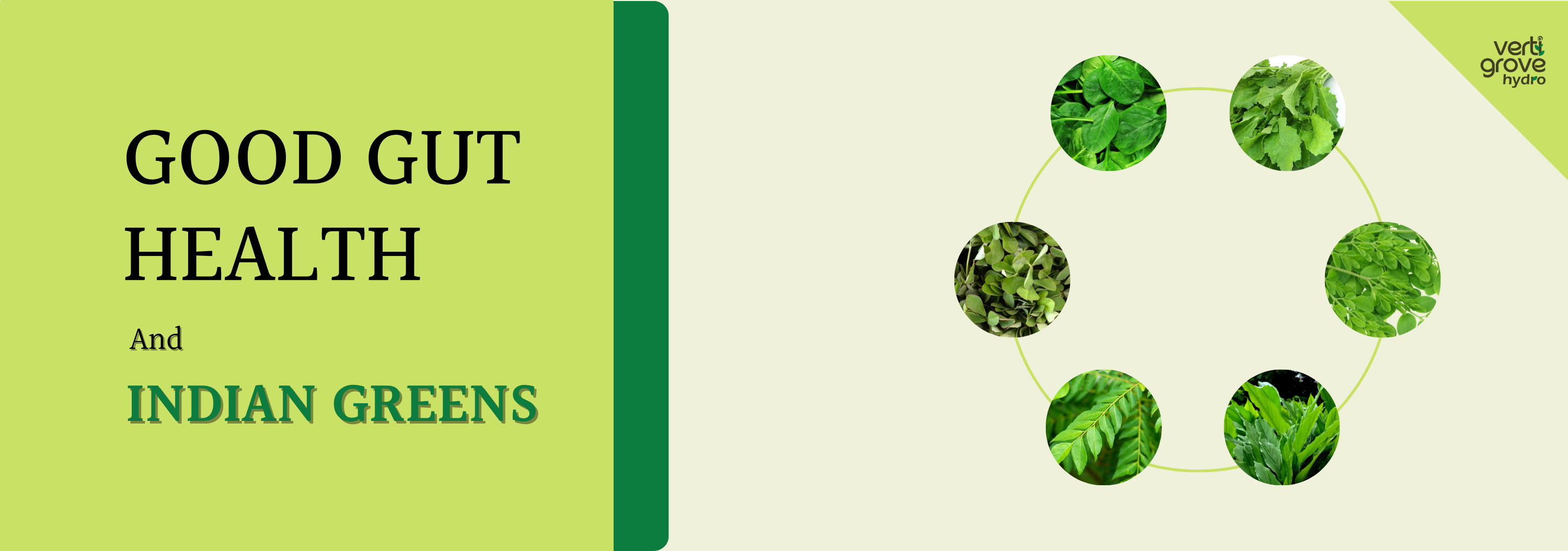
Did you know how important gut health is for our overall well-being? If not, let me tell you that it plays a very important role in performing vital bodily functions.
The gut is responsible for breaking down the food we eat and absorbing nutrients from it. It supports energy production, waste elimination, skin health, etc. Our gut is known as the “second brain”. Gut bacteria can send messages to the brain and even release hormones as well. This signifies that gut health has a direct impact on our mental health. Moreover, 70% of the immune system is housed in the gut! The gut wall acts as a barrier preventing viruses and fungi from entering our blood stream. Poor gut health can translate to low immunity, high risk for chronic diseases, depression, etc.
Our body has a variety of bacteria, most of which are good for us. The gut microbiome is where our good gut bacteria resides in. This bacteria, not only help us digest the food we eat but also contributes to our overall mental and physical health. Moreover, the good gut bacteria keeps the bad bacteria in check. They multiply frequently leaving little space for the bad bacteria to grow. Having a healthy balance of bacteria is what is called equilibrium. Everyone’s gut microbiome is unique. So, the kind of food that is beneficial to one can be harmful to another. The most common intolerances are seen for gluten and lactose.
An easy and effective way to improve your gut health is to include fresh leafy vegetables into your daily diet. Research shows that eating green leafy vegetables contribute good bacteria to your gut. The increase of good bacteria in your gut, limits bad bacteria from reproducing and settling in your digestive tract. Moreover, leafy greens contain fibre, which is also very essential for good gut health. Here is a list of Indian green leafy vegetables that you can include in your daily diet.
Spinach is considered a superfood because of its richness of nutrients and lack of calories. It is packed with vitamin A, K, C and D, dietary fibre, iron, potassium, calcium and magnesium. Spinach can help stabilise glucose levels in your blood and enhances your bone health. It also helps in controlling diabetes as it has a low Glycemic Index. Hence, it is an ideal ingredient in recipes for diabetic patients.
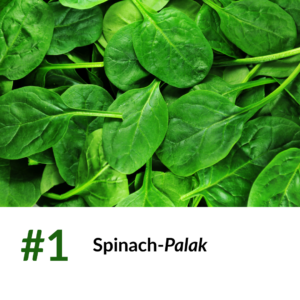

Research shows that mustard leaves have more Vitamin A than Spinach and more Vitamin C that oranges!! Including mustard leaves to your daily diet can result in good lung, heart and kidney health. These also contain a range of phytonutrients that protect our cells from stress and damage.
Amaranth leaves come in different colours ranging from green, red, purple to gold. They are rich in Vitamins A, B, C, K, iron, and potassium. According to Ayurveda, drinking the juice extracted from amaranth leaves can help in curing diarrhoea and haemorrhage conditions. Regular consumption of Amaranth leaves can also help in easing digestion, excessive menstruation and weight management.
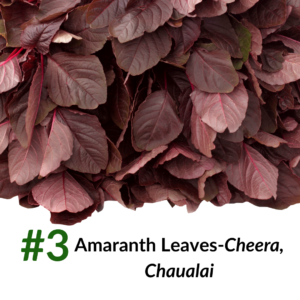

Methi leaves are rich in Vitamin A, K and C, Minerals, and B-Complex minerals like Folate, Riboflavin and Pyridoxine. According to Ayurveda, Methi leaves are also rich in diosgenin that stimulates milk production in lactating mothers and it also helps in inducing labour. The folate in Methi leaves is important for multiplication of RBCs and WBCs in our blood. This makes it a very good food for iron deficient people. It is also recommended for adolescent girls to pregnant mothers.
Curry leaves have a wide range of medicinal and therapeutic benefits. Packed with essential vitamins, carbohydrates, fibre and volatile oils, curry leaves play a vital role in controlling treating heart problems, preventing infections and also providing beautiful hair and skin. The extract from Curry leaves is commonly used to treat diabetes. It also acts like a detox and cleanses your body from within when eaten raw or in the form of a juice.


According to research, Moringa leaves have 7 times more Vitamin C then oranges and 15 times more potassium than bananas. It is also rich in calcium, iron and amino acids that are essential to build muscles and heal your body. Moringa leaves are proven to be able to combat arsenic toxicity. Moreover, they support brain health and act as neuro-enhancers.
Turmeric leaves contain curcumin that triggers bile production which is essential for digestion. Curcumin also has strong anti-inflammatory properties, hence, that makes turmeric leaves highly beneficial for patients of osteoarthritis and rheumatoid arthritis.

Make sure to include these or any other leafy vegetables of your choice to develop and enhance your gut health. It’s very important to ensure that your green leafy veggies are fresh and nutritous. What better way to ensure this than growing it yourself! Most leafy vegetables are easy to grow and don’t require much maintenance.If you live in a city and don’t have much space to grow vegetables, check out Vertigrove-hydro Starter Kit to grow your favourite herbs and vegetables.
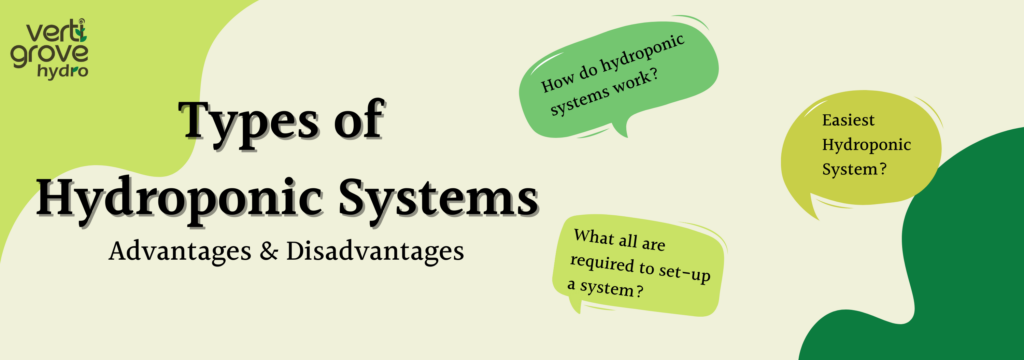
Hydroponics refers to growing plants in a nutrient rich water solution without soil. It is proven to ensure faster growth,
higher yield and a more nutritious produce. This is simply because the plants are given exactly what they need when
they need it. It is the best way of growing plants for city dwellers who don’t have much land to themselves. Moreover,
hydroponics helps you conserve almost 90% of water in comparison to when growing plants in soil. If you want to read
more about hydroponics and the science behind it, check out our blog – “Hydroponics and its Benefits”.
In India, we are seeing a rise in interest towards hydroponics from home growers. This is majorly because of the recent
shift of people towards cities where you only have a balcony or a small terrace to grow anything. Also, given today’s
busy lifestyle, many find it difficult to grow vegetables or even maintain a garden using traditional methods, i.e., in
pots or grow bags with soil. So, as our way of living changes its only natural that we look for more advanced and
evolved methods of farming for ourselves that is more suitable to our lifestyle.
i. Reservoir : An opaque air tight container. The capacity of the container depends on how many plants you wish to grow. For example, if you are growing small plants like Spinach, you require around 2 litres per plant.
ii. Air pump: This is to provide oxygenation for better nutrient absorption.
iii. Net pots: These are required so that the roots can easily grow out of the pot. Net pots are available in various sizes: 2″, 3″, 4″, 6″, etc. Most commonly used one is 2″ diameter netpots.
iv. Clay Balls/Rockwool/Coco peat/Foam: These are to hold the plant firmly in the pot. The main requirement is that it should be able to hold moisture and shouldn’t alter the pH of the solution.
v. Hydroponic Nutrients: Hydroponic nutrients should consist of all the essential elements required for plant growth as the plants are completely dependent on it. Plants mainly require Nitrogen, Phosphorous, and Potassium (N-P-K) along with a
range of micro and macro nutrients. Hydroponic nutrients are available in different ratios of the required elements.
vi. TDS Meter: A TDS (Total Dissolved Solute) meter is used to measure the nutrient concentration in the solution.
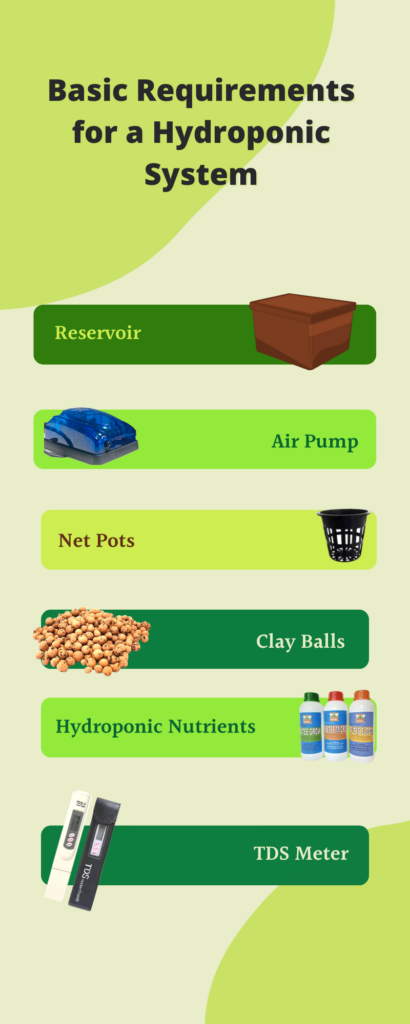
If you want to set-up a hydroponic system on your own for your home, the easiest type is a Deep-Water Culture (DWC)
System (Explained in detail below). In a DWC system you can grow small plants such as Mint, Spinach, Amaranth, Kale,
Lettuce, etc. You can get seedlings of the plants of your choice from a local nursery and simply wash the soil of the
roots and place it in your system.
There are different types of hydroponic techniques: Deep Water Culture, Nutrient Film Technique, Aeroponics, etc.
Our system- Vertigrove-hydro uses a combination of DWC and NFT technique for optimum results. Let’s get into the
details of each technique and understand their respective set of advantages and disadvantages.
DWC is ideal for beginners as it is the simplest way to start learning hydroponics. The plants in net pots are placed on the lid of the reservoir such that the roots are dangling inside. The reservoir will be filled with nutrient rich oxygenated solution. The solution is oxygenated using the air pump and stone. Since the plant roots are submerged in water constantly proper oxygenation is very essential.
You need to ensure that only the plant roots are exposed to the nutrient solution and not the stem or any vegetative part of the plant.
It is also advised to maintain the water level in the reservoir such that about an inch of the root remains above the waterline.
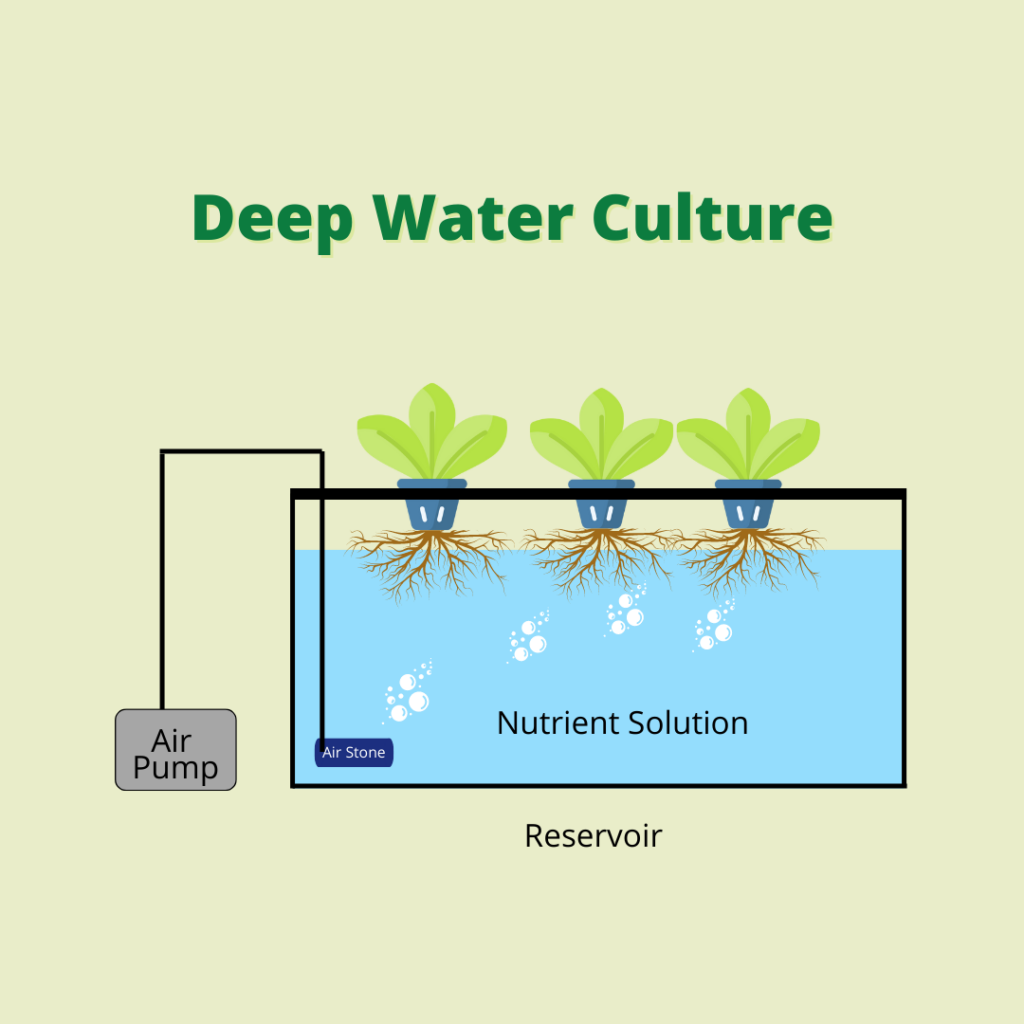
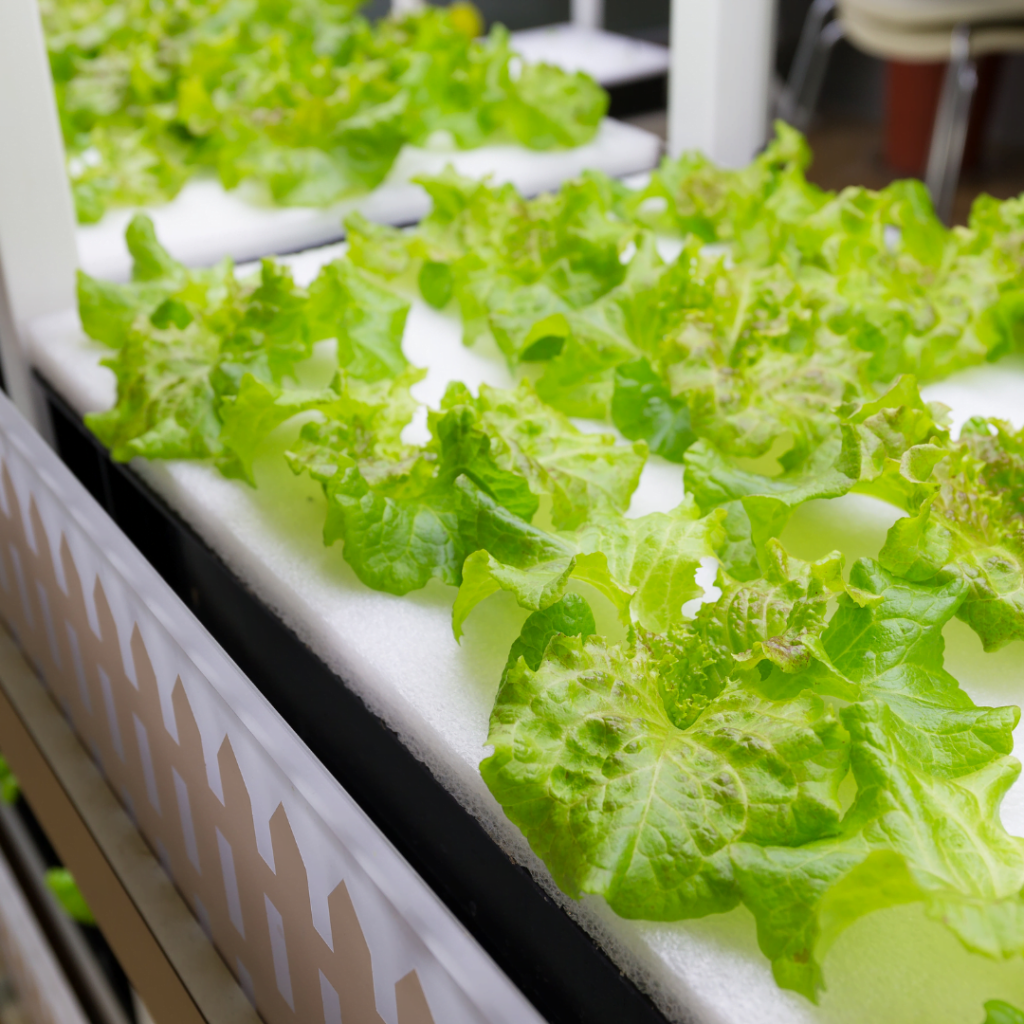
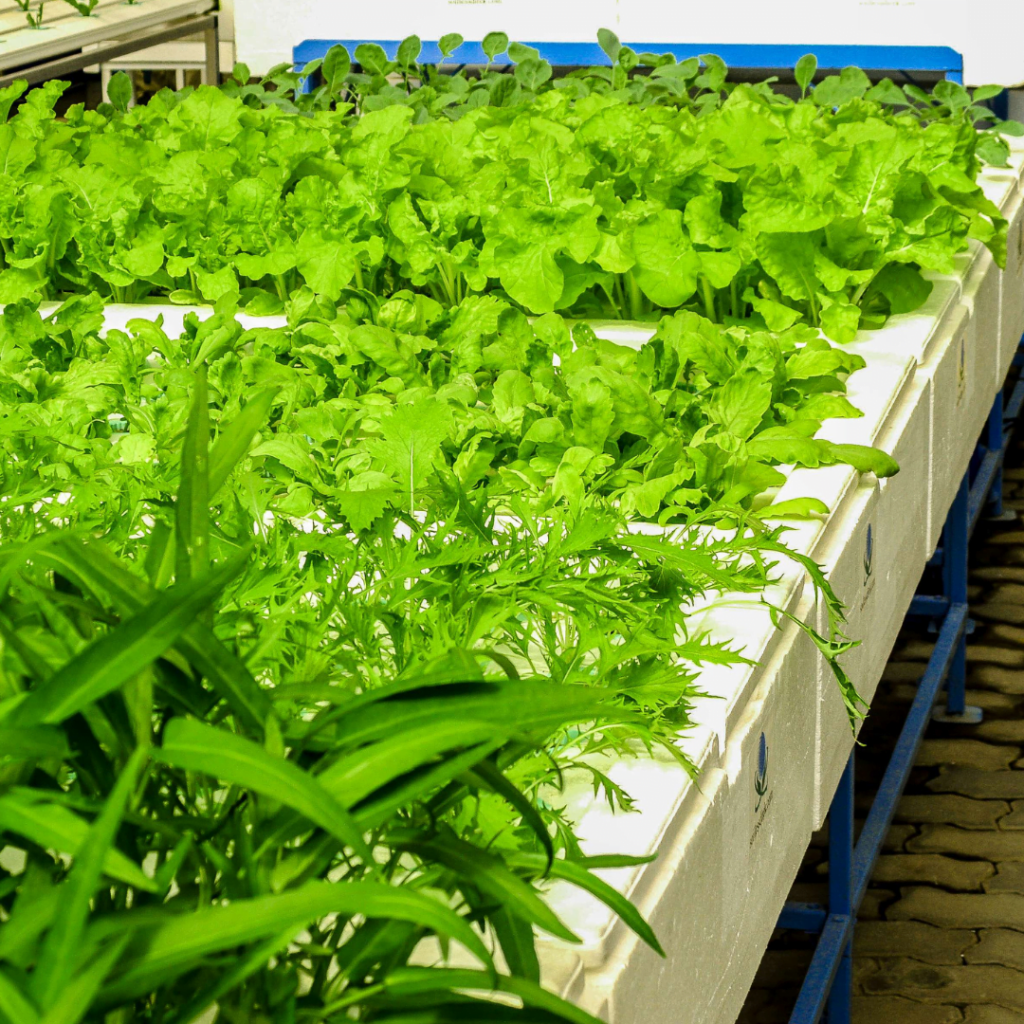
Unlike in DWC systems where the plant roots are completely submerged in water, in an NFT system the plant
roots are exposed to only a thin stream of nutrient rich solution that is constantly being circulated.
An NFT system consists of a reservoir with rectangular or cylindrical channels to hold plants connected to it. Plants in net-pots are placed on the channel such that the roots are inside. A submergible pump is placed in the reservoir which will pump the solution to the channels. The channel is placed slantingly such that the solution flows downwards and back to the reservoir. An air pump and stone are also placed in the reservoir to ensure proper oxygenation.
A thin stream of the nutrient solution passes through the channels such that only the edge of the plant roots is in contact with it. This also means that a good part of the roots is exposed resulting in plenty of room for oxygen. NFT systems are very popular among commercial growers. These are mostly suitable for light weighted plants like lettuce, kale and spinach. To grow heavier fruiting plants, you would require to provide extra plant support.
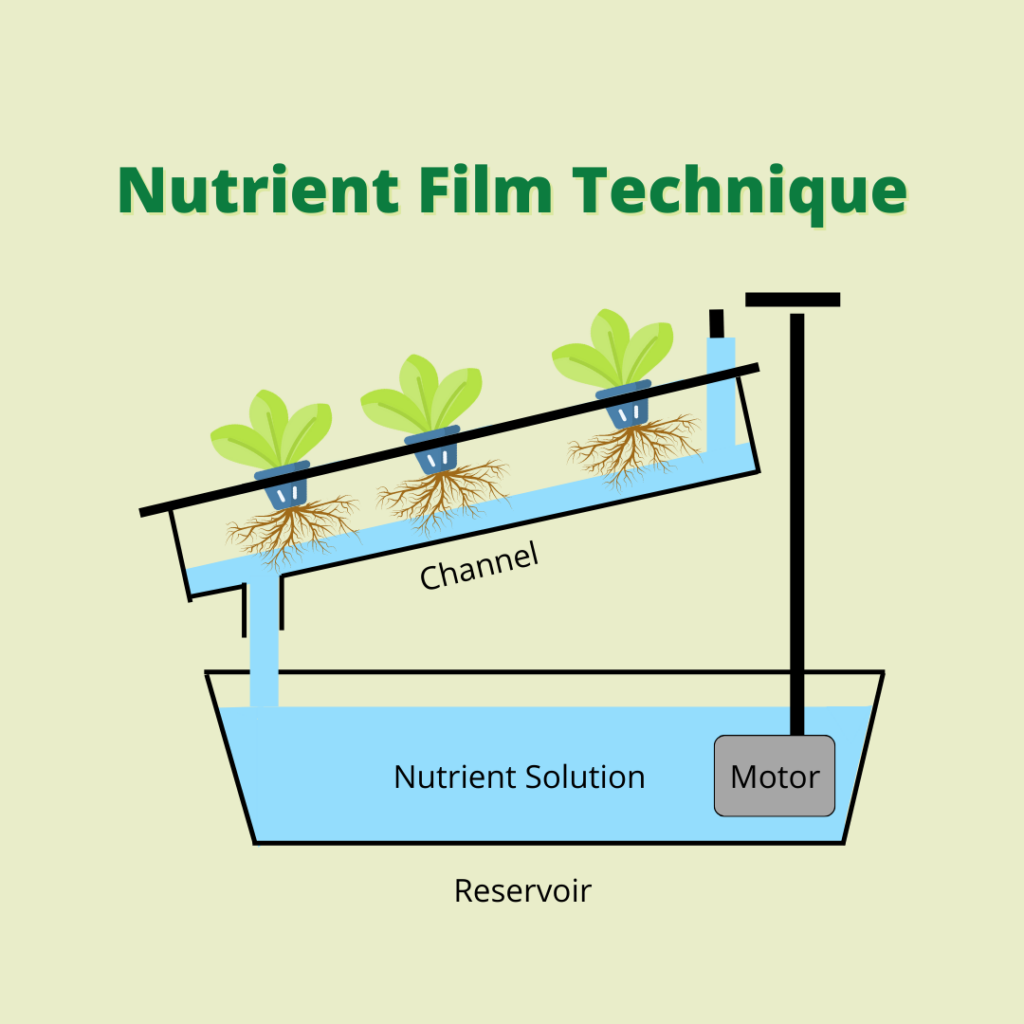
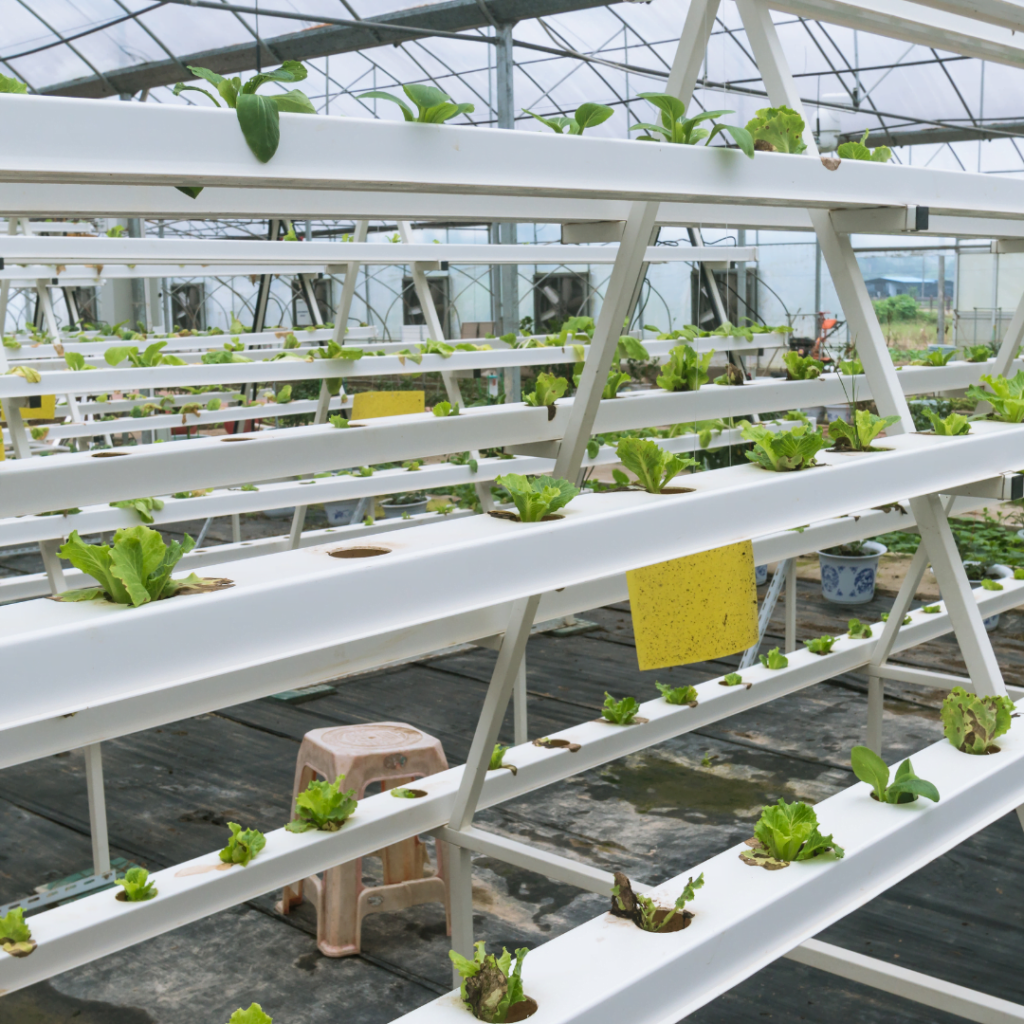
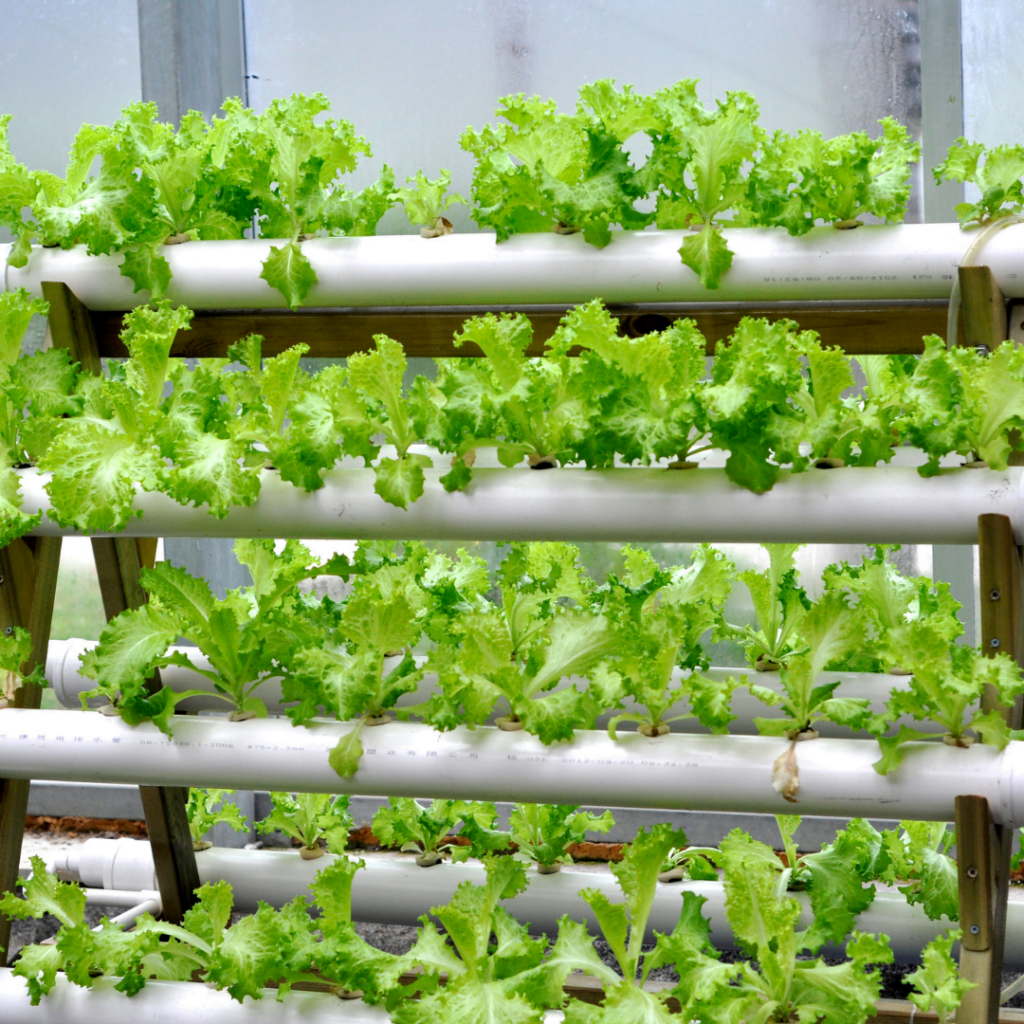
In an aeroponic system the plant roots are exposed to a nutrient filled mist. In this technique plant roots are not supported by any solid growing medium (such as clay balls, rock wool etc.). Instead, the roots would be dangling in air inside a closed loop system. Hence, a collar (For eg. Made with foam) is to be added to the plants in the net pots to hold the stems firmly.
Plants in net pots are placed on the lid of the reservoir. The reservoir will be filled with the nutrient rich solution. A pump placed inside the reservoir will pump the solution to the sprinkler system. These sprinklers will periodically spray the solution to the dangling roots.
Compared to other hydroponic systems, plants grown aeroponically grow faster as they can absorb nutrients more efficiently. This is simply because the plant roots are exposed to more oxygen.
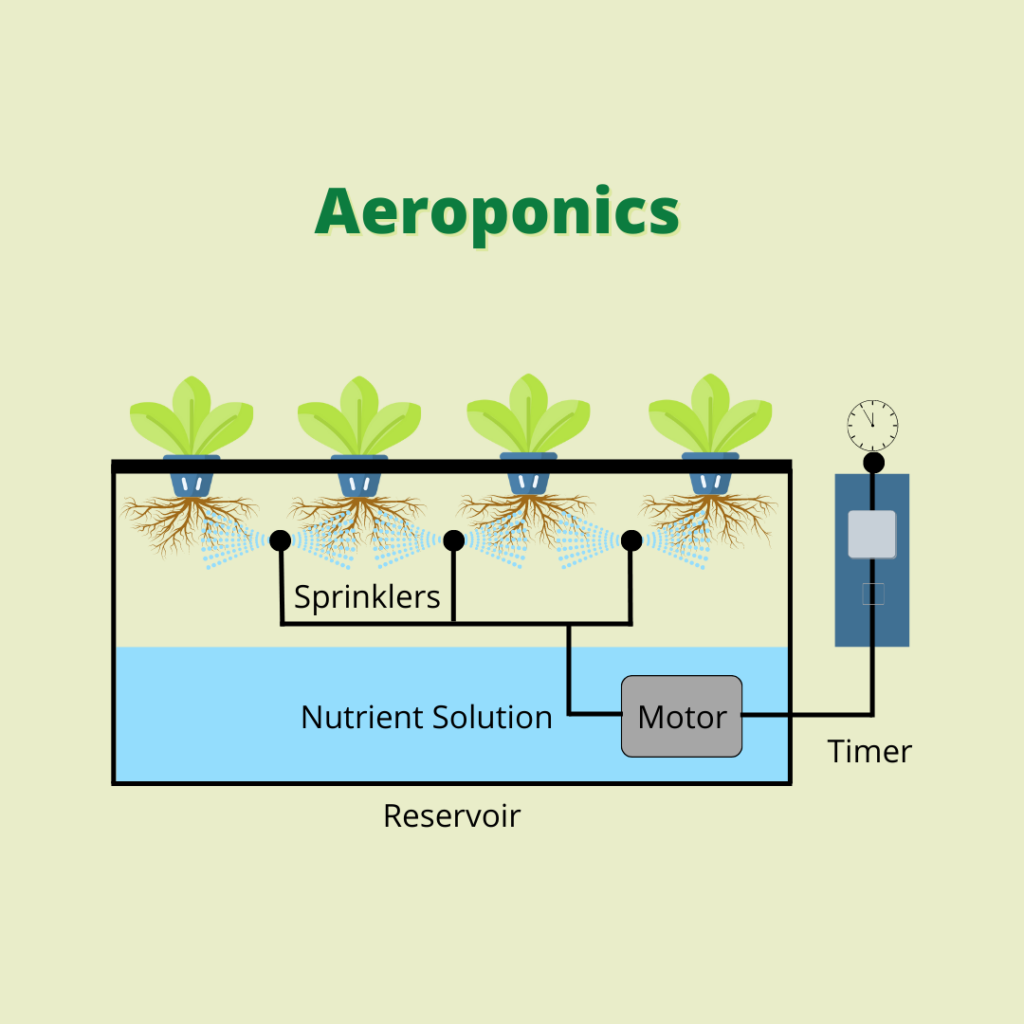
All these hydroponic systems have their own set of advantages and disadvantages. If you wish to start growing plants
hydroponically, depending on your budget, time and space you can choose the technique suitable for you.
We have extensively studied each technique before designing Vertigrove-hydro. Hence, we have tried to incorporate
the advantages of each technique and tried to eliminate the disadvantages.



One major disadvantage common in all is that during power failures the plants are adversely affected. So, Vertigrovehydro is designed such that it can withstand power-cuts upto 12 hrs. This is because it uses a combination of DWC and NFT techniques, wherein the water is collected in each pot and at the same it’s being circulated as well. The water collected in each pot drips down to the pot below very gradually, hence the pots are able to hold water in it for a long time. This ensures that plants have access to nutrient rich water at all times.
Another advantage of Vertigrove-hydro is that, because of its structure, it can easily support fruiting vegetables and creepers. The pots are designed such it’s diameter and height are suitable for the extensive root system of fruiting vegetables.
A person trying hydroponics for the first time might find the concept a little technical and could have a tough time trying to navigate through the pool of resources available on the internet. So, we will handhold you throughout your journey till you are an expert of hydroponics yourself!
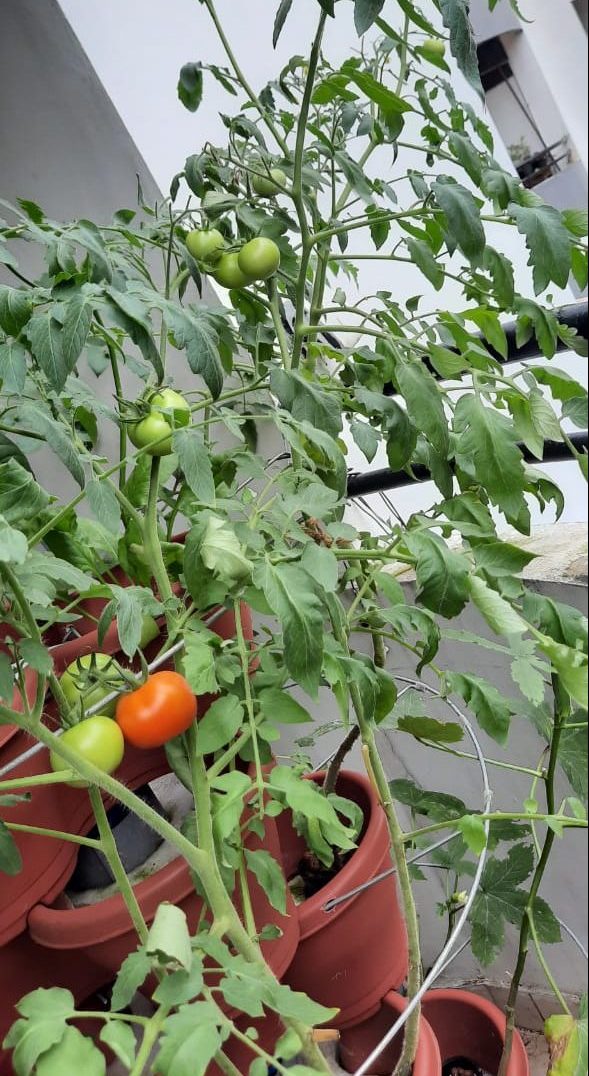
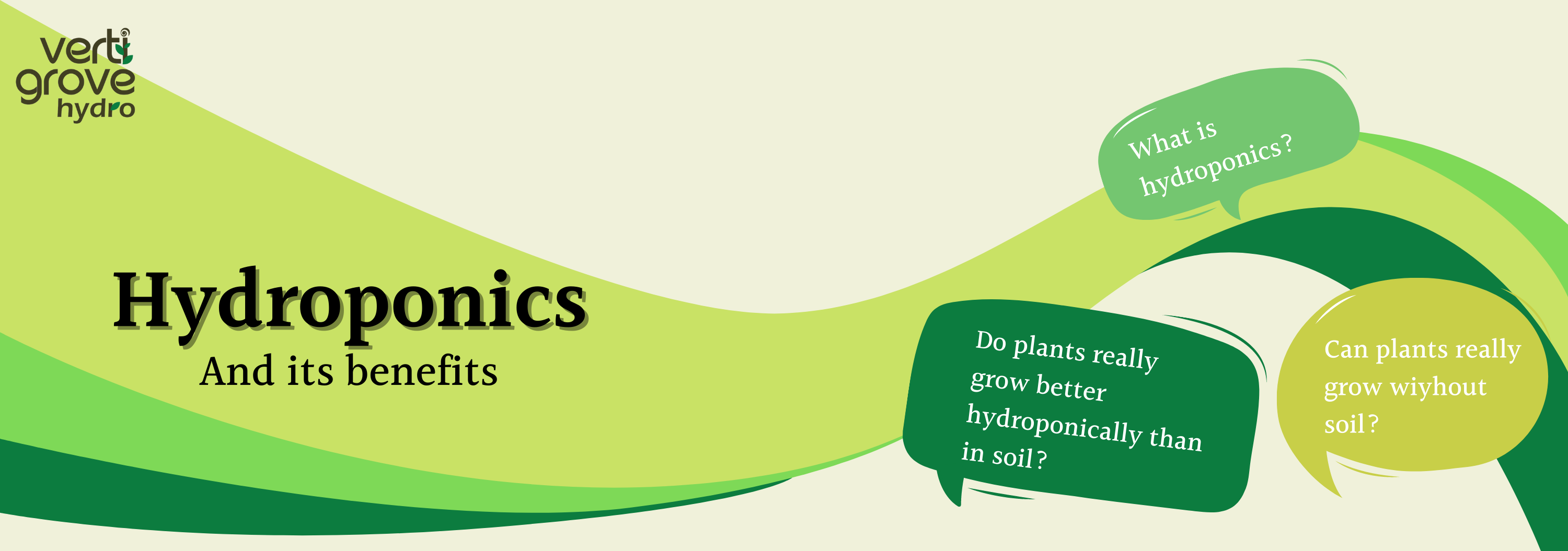
Hydroponics is a fast-growing concept and is reaching commercial and home growers at a fast rate. The increase in popularity of the technique is simply because of its significant advantages when compared to soil farming. A better understanding of the science behind hydroponics is helping growers to maximize their yield with minimum resources.
Let’s get into the basics of hydroponics. Hydroponics is basically a technique of growing plants without soil! It is a method of growing plants in water with the essential nutrients dissolved in it. The plants are placed in net pots such that their roots are in touch with nutrient rich water and the plants are secured in the net pot usually using clay balls.
A lot of people are surprised to know that plants can grow with out any soil! So, let’s dive into how that’s possible. For this, first we need to understand what a plant needs to grow. As we all know, plants grow through a process called photosynthesis, in which they convert water, minerals and carbon dioxide in the presence of sunlight and chlorophyl into glucose and oxygen.
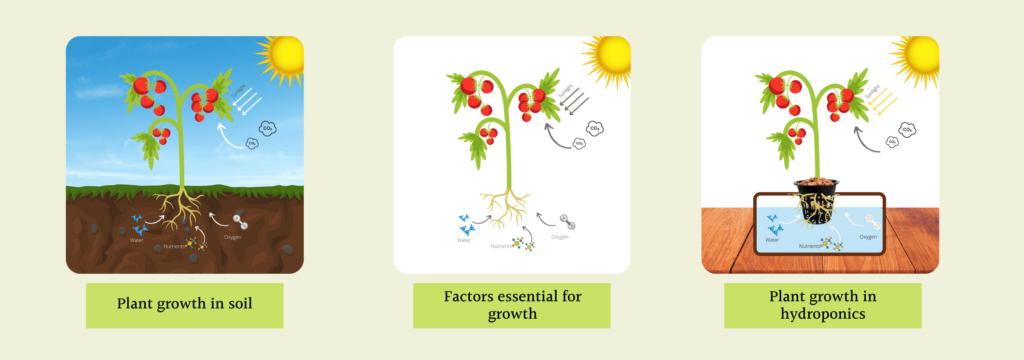
If you have noticed, there’s no mention of soil here! Plants grow in soil because it contains water and minerals. So, if plants get these by standing with their roots in a mineral rich water solution, they can do without soil altogether.
There are variety of hydroponic systems, but all have certain basic common requirements for plant growth:

Yes, it’s proven that plants show much better growth when grown hydroponically. This is simply because the plants are getting the right nutrients at the right stage in the form that it can be easily absorbed. Plants can absorb nutrients only in its ionic form. The major difference in the nutrients in soil and in hydroponic method is that the former requires bio-active intervention before it can be absorbed and the latter is ready for immediate uptake.
Plants require mainly 3 elements for proper growth: Nitrogen, Phosphorous and Potassium.

Plants cannot directly absorb nutrients from fertilizers or manure present in the soil. For example, let’s look into how plants absorb nitrogen.

What we need to understand is that the nutrients that plants absorb in hydroponics are exactly the same as the ions resulting after this complex process. So, in hydroponics plants can absorb the nutrients faster and much more easily and hence they grow faster, produce higher yields and are much more nutritious as well.

If you are interested in setting up your own hydroponic garden in your home balcony, give Vertigrove-hydro a try! Vertigrove-hydro is a vertical hydroponic system in which you can grow upto 36 plants in just 4 sqft. It is designed exclusively for urban dwellers who have space and time constraints. Contact us here to know more.
Vertigrove-hydro is designed to grow the maximum number of vegetables and plants in minimum space with highest productivity consistently. Based on our 3 years of extensive research we have developed various features in Vertigrove-Hydro to address the needs and concerns of an urban farmer.
Vertigrove-Hydro is designed on a vertical structure to grow maximum plants in minimum space (up-to 48 plants in 4 sqft). But crowding plants together will adversely affect their growth and productivity as plants don’t have enough space for root growth and also the amount of nutrients that any of the plants can absorb would be less.
So, we choose to use hydroponics technology as plants can be grown very closely. Also the productivity of Hydroponically grown plants is 50% more and is consistent. Leveraging hydroponics not only ensures maximum productivity of plants in less space but will also lead to faster growth, higher yields and a more nutritious produce.
Vertigrove-hydro can be placed outside under direct sunlight. The pots are made of high-quality plastic resin that ensures all-weather durability and is 100% UV stable to prevent fading and cracking. Also, sunlight comes in patches, so Vertigrove-hydro is designed with castor wheels to make it portable. You could either move it around to ensure plants get maximum sunlight or even move it indoors in case of heavy rains.
Plant roots need oxygen to better absorb nutrients and even water. Without enough oxygen, plants are likely not to grow to their full potential, in part because they aren’t taking nutrients in effectively. In Vertigrove water is constantly falling. This falling water agitates and causes bubbles to form in the water being collected in each pot, thereby it provides aeration to the roots by increasing the dissolved oxygen levels. The height at which the water falls is optimised to ensure perfect aeration. Also, the airtube fixed in the pump will provide additional aeration to the plants. Also protection is provided to prevent heating up of the air bubbles as this is critical for growth of the plants.
The plants receive nutrients through the nutrient rich water in the water tank. The nutrients are to be added as per the chart that we provide.
Most hydroponic systems need to be plugged in 24*7. So, in cases of power failures the system would stop functioning and if the power is gone for longer durations the plants may even die. This would affect the efficiency and productivity of the system. Hence, Vertigrove has a provision wherein a certain amount of water would be collected in each pot as the water flows. This will ensure that even in case of a power cut the roots will have access to the nutrient rich water.
Most hydroponic systems let you grow only leafy vegetables. This is because in these systems, the plant roots do not have much space to grow and leafy vegetables being shallow rooted are the only ones possible. Whereas Vertigrove-hydro is designed such that the roots have sufficient space to grow as long as needed. So, it can easily support deep rooted plants such as tomatoes, okra, beans, cucumbers, etc.
Now unlike leafy vegetables, fruiting plants grow big in size and also could be creepers. To support such plants, Vertigrove-hydro is designed with creeper guards. Thereby you would not need to tie the plants or provide any external support and the system can continue to be portable.
We want Vertigrove-hydro to present to our customers a hassle-free farming experience. The major inconvenience for urban growers is cleaning their balcony or terrace after each rain or taking out time often to water each and every plant.
Vertigrove-hydro is designed to be spill proof and mosquito proof; it can be easily moved around for cleaning purposes as well. Also, because it uses hydroponics there is no question of watering each plant or even weeding. All that needs to be done is to check the nutrient level in the water (TDS Level) and pH levels once in a while.
The pots are aesthetically designed and available in different colours and are attractive hence they can be kept inside the living room or bedrooms of the house.
For busy executives who don’t have the time for this, there is an optional feature of integrating with IOT. In this, the TDS and other parameters can be checked remotely by connecting to the IOT sensors from your SmartPhone using the Vertigrove App. These sensors will read the parameters and display it on your smartphone.
Customers need to follow a standard procedure for providing the nutrients. Pest control solutions to the plants and required nutrients are easily available in the market.
Vertigrove is not just a product, but through it we wish to build a community of urban dwellers who can reconnect with nature and thereby sustainably grow their own food. For this we have a support app that lets our customers stay connected to us. The app has a provision for customers to raise a ticket in case they are facing an issue. They can simply click an image of the problem and upload it. Our team of experts would get back to them immediately with a resolution. The app would also be used as a platform to share the latest advances in urban farming with our community.

Improving customer experience is a constant process and we are always looking for new ways to enhance how our customers would farm using Vertigrove. Our aim is to enable urban dwellers who lead extremely busy lives to experience the joy of growing their own food and reconnect with nature.
Backyards are places where we spent most of our daily lives. Kerala in the eighties had cosy backyards with a well, cowshed, fruit trees and a kitchen garden. Children grew up in this space, grandparents rested here and this area bustled with activity during the harvest and festival seasons.
Today our backyards are smaller balconies. A much-needed private space in flats, this is where a little boy practices his penalty shots, its where we dry our clothes and sometimes kitchen spices, our grandparents catch a little sun while reading the paper and at dusk this balcony is a moonlight haven for a romantic teen. Some of us who grew up on farms sometimes squeeze in a kitchen garden here. The difficulties before a balcony farmer are the following.

The little patch of sunlight moves during the day and one would practically want to move the entire garden to catch the sun. Green leafy vegetables need at least 4 hours of sunlight and Fruiting vegetables need 8 hours of sunlight in a day. Unless we have a mobile unit that can pull the plants to catch maximum sunlight all the work that is put into farming is futile.
The monsoon woes of the balcony farmer! The intense rains completely soak the Grow bags and the muddy water messes the balcony. Cleaning the mess is a chore and energy draining. One then has to restore the garden. That means getting more potting mix all the way from the local agricultural farm, shoving it up to your high-rise nest and then adding it on to the grow bags and replanting the vegetables. Only to have the next shower wreak havoc!
Balconies are the only outlet for nature in an otherwise overcrowded living space. It is the little one’s playground, the elders’ gym, the housewives work area and the urban farmer’s garden. All in one. The more compact the garden the more the balcony is utilized and the small patch of green enhances the other utilities but grow bags that occupy too much space reduce the balcony into a neglected corner.
Every farmer dream is a plentiful harvest. The hours of weeding, nurturing and labour is fulfilled when a bowl of tomatoes, a handful of beans and cucumber or 2 grace the kitchen counter. Sometimes however one tries a bountiful harvest evades the urban farmer. If backyard farmers have to thrive, they need innovative technology that can help boost the productivity so that farmer is inspired to carry on.
The kitchen gardens need to be compact, highly productive, soilless and easy to manage. Vertical farming solves the issue of space constraint. Hydroponics and good nutrient management gives a better yield . Soilless farming removes the challenge of muddy terrace. And IOT technology can cut the time spent on the garden and make it all a lot easier. As Theodore Roosevelt rightly said – “Do what you can, with what you have, where you are.”
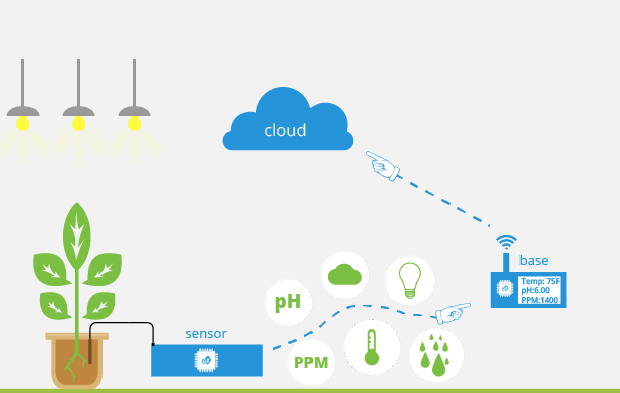
With the growing adoption of the Internet of Things (IoT), connected devices have penetrated every aspect of our life, from health and fitness, home automation, automotive and logistics, to smart cities and industrial IoT.
Thus, it is only logical that IoT, connected devices, and automation would find its application in our own kitchen garden and as such, tremendously improve nearly every facet of it. How could one still rely on plows when self-driving cars and virtual reality are no longer a sci-fi fantasy but an everyday occurrence?
Farming has seen several technological transformations in the last decades, becoming more industrialized and technology-driven. By using various smart agriculture gadgets, farmers have gained better control over the process of growing crops, making it more predictable and improving its efficiency.
What is smart agriculture? The definition and market size
Smart agriculture denotes the application of IoT solutions in agriculture. The same applies to the smart farming definition.
The adoption of IoT solutions for agriculture is constantly growing. Namely, BI Intelligence predicts that the number of agriculture IoT device installations will hit 75 million by 2020, growing 20% annually.
At the same time, the global smart agriculture market size is expected to triple by 2025, reaching $15.3 billion (compared to being slightly over $5 billion back in 2016).
How does Smart Agriculture work?
Real time data is read from the farm like, plant growth, nutrient level, moisture level, humidity, ph of the growing medium and transmitted over the WIFI and uploaded in the cloud from which after analytics notifications are sent to users to take corrective actions.
The Benefits of smart farming: How’s IoT shaping agriculture
Technologies and IoT have the potential to transform agriculture in many aspects. Namely, there are 5 ways IoT can improve agriculture:
As a result, all of these factors can eventually lead to higher revenue.
Some of the IoT applications in agriculture in general:
Applying IOT Agriculture will ensure that mundane tasks like watering can be automated.
Smart farming sensors monitors the humidity and moisture level in the plant roots. This data can help us to intelligent decisions like reducing the water quantity or not to water at all.
Smart Agriculture will monitor the ph of the growth medium much in advance so that it can be rectified rather than wait for post-mortem corrective actions.
Instead of making intuitive and inexact decisions regarding what fertiliser to use and how much, applying IOT in agriculture ensures that accurate Nitrogen, Phosphorus and Potassium levels are monitored and maintained.
Smart Agriculture is the Future!
Applying Data analytics to our kitchen farms will revolutionise agriculture. Farming will not be the same again with powerful data analytics capabilities and predictive algorithms. The future is here.
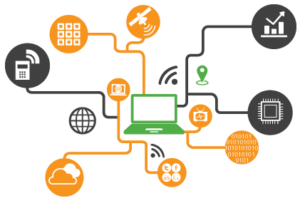
What is Internet of Things (IoT)?
Internet of Things (IoT) is an ecosystem of connected physical objects that are accessible through the internet. The ‘thing’ in IoT could be a person with a heart monitor or an automobile with built-in-sensors, i.e. objects that have been assigned an IP address and can collect and transfer data over a network without manual assistance or intervention. The embedded technology in the objects helps them to interact with internal states or the external environment, which in turn affects the decisions taken.
IOT enables devices/objects to observe, identify and understand a situation or the surroundings without being dependent on humans. By gathering and processing vast amounts of data its possible to quantify and analyse all manner of things that was once done intuitive and inexact.
What is the scope of IoT?
Internet of Things can connect devices embedded in various systems to the internet. When devices/objects can represent themselves digitally, they can be controlled from anywhere. The connectivity then helps us capture more data from more places, ensuring more ways of increasing efficiency and improving safety and IoT security.
IoT is a transformational force that can help companies improve performance through IoT analytics and IoT Security to deliver better results. Businesses in the utilities, oil & gas, insurance, manufacturing, transportation, infrastructure and retail sectors can reap the benefits of IoT by making more informed decisions, aided by the torrent of interactional and transactional data at their disposal.
How can IoT help?
IoT platforms can help organizations reduce cost through improved process efficiency, asset utilization and productivity. With improved tracking of devices/objects using sensors and connectivity, they can benefit from real-time insights and analytics, which would help them make smarter decisions. The growth and convergence of data, processes and things on the internet would make such connections more relevant and important, creating more opportunities for people, businesses and industries.
A few applications of IOT are given below.

Spinach does give you superpowers ! See what I found on the net .
Recently a critical discovery about how bacteria feed on an unusual sugar molecule found in leafy green vegetables could hold the key to explaining how ‘good’ bacteria protect our gut and promote health. Researchers from Melbourne and the UK identified a previously unknown enzyme used by bacteria, fungi and other organisms to feed on the unusual but abundant sugar sulfoquinovose — SQ for short — found in green vegetables. Each year, leafy green vegetables — such as spinach — produce the sugar on an enormous scale globally, comparable to the world’s total annual iron ore production. Bacteria in the gut, such as crucial protective strains of E. coli, use SQ as a source of energy. E. coli provides a protective barrier that prevents growth and colonisation by bad bacteria, because the good bugs are taking up all the habitable real estate,” Dr Goddard-Borger said.”E. coli is a key bacterial coloniser needed by our gut. We speculate that consumption of this specific molecule within leafy greens will prove to be an important factor in improving and maintaining healthy gut bacteria and good digestive health.”
A few years ago a talk by an endocrinologist from Amrita Hospital told us how the traditional Indian Ayurveda practices had applied the principles of good gut bacteria a few centuries ago. Practices such as imbibing herbal medicines , of drinking butter milk after every meal and vegetarian dietary habits with high amount of leaves was how our ancestors were able to lead healthy lives. Gut bacteria had a role to play in our Metabolism, our immunity to cancer, diabetes and even our neurological state!
A survey by WHO says the average Keralite consumes 8gm of green leafy vegetables daily whereas the required is 40gm daily. The onslaught of cancer and sedentary diseases in our state is a direct result of this low consumption. And we all know why. None of us actually farm and to buy green leafy vegetables that might have high pesticide content is not a very healthy option.
This is why we came up with VertiGrove , thirty plus plants consisting of spinach, palak, amarthus , in 4 square feet in your balcony will help provide the magical superpowers we all need to live healthy ! And just in case you don’t know what do with it, try these recipes.
Working as management representative in software industry has given me an insight into corporate goal setting and achieving the targets. One of the most important aspects of this is about setting a target that is s.m.a.r.t, Specific, Measurable, Achievable, Relevant and Timebound. In order to achieve targets in software its important understand what are the relevant indicators of good health of the quality management system, also what that ideal values these indicators should have and more importantly if it’s under constant monitoring and if the deficiencies are corrected before damage .
Farming depends on the most unpredictable factors. We developed VertiGrove during the summer and ensured that the soil moisture was measurable and could be controlled but when it rained the increase in humidity meant that automatic irrigation had to be adjusted according to it.
This turned out to be a blessing in disguise for us since then our team had to understand what were the relevant indicators of plant health ie, potting mix moisture, humidity, ph of the potting mix and water , EC of the potting mix and water , the NPK content and the micronutrients in the potting mix. The second task was to understand the optimum levels of the indicators and to measure the real time readings against this standard and fortify the deficiency.
We are currently working on a system that will notify the client on the moisture and the nutrient content so that it is corrected immediately. We believe that the urban farmer will definitely harvest a better yield if she is able to understand the science behind it.
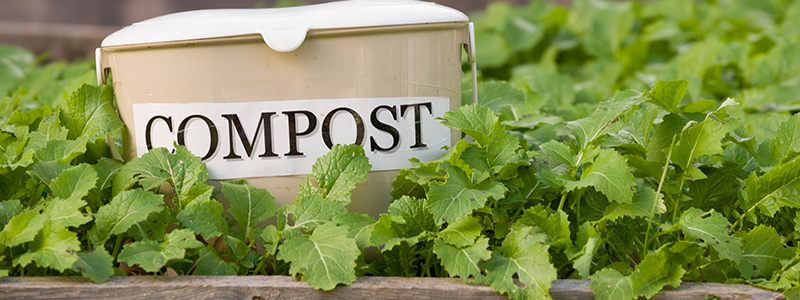
Every June 5th we celebrate World environment day. Our environment defines our very existence and hence should get the highest priority in our lives. Today we collect together , conduct cleaning of our cities, create awareness of best practices of plastic recycling and we plant trees. But since our sustenance is at stake and shouldn’t we be doing consistent sustainable work in this area everyday? How can we live in peace knowing that our only planet is dying because of our irresponsibility and selfishness. Surely we need to put more efforts so that we can reverse this?
These questions bothered me as a student of chemistry and when I read up on global warming way back . As a mother I grew more and more frustrated that I could not contribute at all.
I knew that my small actions today would make or break the future generation and decide to include sustainable activities in my routine. Composting and nurturing a small backyard garden gave me a little peace of mind. Knowing that I was sorting at source, ie segregating kitchen waste from plastic at source and composting my waste changed my perception towards solid waste management. I realized as a homemaker I could make a difference in global warming with this simple exercise. Methane , which is 70 times more potent than carbon dioxide as a green house gas is produced when organic waste is thrown to landfills. Instead if we compost it at home we get manure to nurture a small backyard garden. Composting meant that I was fostering a miniature ecosystem in my backyard. A kingfisher, 2 minnas and an assortment of birds thronged my kitchen garden. Living in the middle of the city I felt I was making a small positive difference.
Sorting and segregating plastic at source at home became part of my kitchen work. Cleaning milk covers , fish and meat wrappers and hanging them to dry near my sink became a habit. Clean plastic didn’t smell bad. Dry plastic didn’t attract flies. It was just another raw material for another process to make another product.
Talking about composting and the relevance of eating green leafy vegetables and sharing good practices of recycling in schools and residential areas came next. Holding collection drives in schools highlighted the fact that with a little care and attention we as a nation can dream of a more environment conscious society. Then we can really earn the right to live in this beautiful blue magical planet.
Have more questions? Would like to reach out to us?
Then please fill out this form.
WhatsApp us